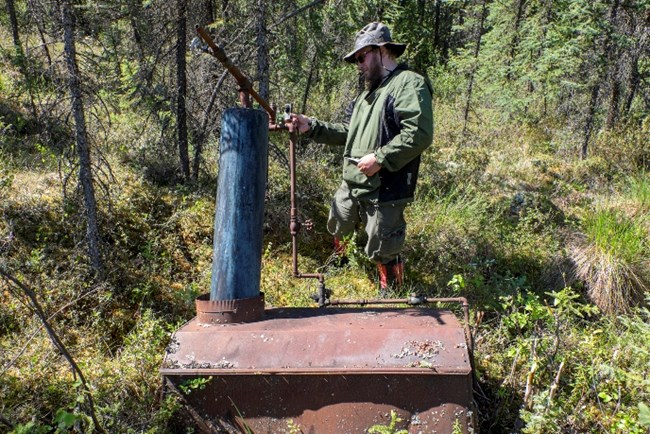
NPS/Josh Spice
-Fairbanks Daily News-Miner, October 24, 1938 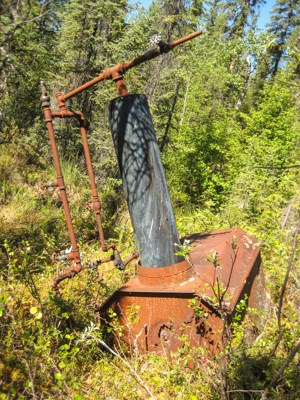
NPS/Chris Allan In 1898 when thousands of eager gold-seekers rushed to Alaska and the Klondike, they encountered an obstacle that many did not anticipate: permafrost. Unlike at southern latitudes, the ground in the Far North was frozen all year round, locking the gold in an icy embrace. The earliest arrivals in northern gold fields had no choice but to build wood fires to melt the rock-hard combination of soil, gravel, and ice, but the work was painstakingly slow. The process of drift mining involves digging vertical shafts down to bedrock and then horizontal tunnels along the gold-rich layer called a paystreak. Building wood fires was not only inefficient—it used large amounts of wood and only thawed about one foot of gravel in a day—but the tunnels quickly filled with smoke and carbon monoxide which burned the miners' eyes and could kill by asphyxiation. A Boiler Revolution The Klondike-Alaska Gold Rush inspired much innovation, particularly in the field of thawing. An inventor named Greenleaf W. Pichard tried and failed to use an electric-powered furnace to melt frozen ground; others pumped hot water into and out of their mine shafts; and it was an accident in 1898 that led to the widespread use of steam in the thawing process. A Dawson miner named Clarence Berry was using a steam-powered hoist to drag logs up a hill to his mining claim when he noticed that steam spouting from an exhaust hose had melted a hole in a pile of frozen gravel. 
Courtesy of Eagle Historical Society Further experimentation led to the invention of the steam point, a steel pipe used to deliver steam deep into the frozen earth. By the following year most of the miners in the Klondike goldfields had begun using rubberized hose to connect steam boilers to lengths of steel pipe, which they then hammered into the earth. Early on there was no hydraulic pipe available, leading some to use old rifle barrels welded end to end. By fastening a bit to the end and employing multiple points at once, miners would thaw and excavate more gravel than ever before. As early as 1898 U.S. Consul James McCook, stationed at Dawson City, explained:
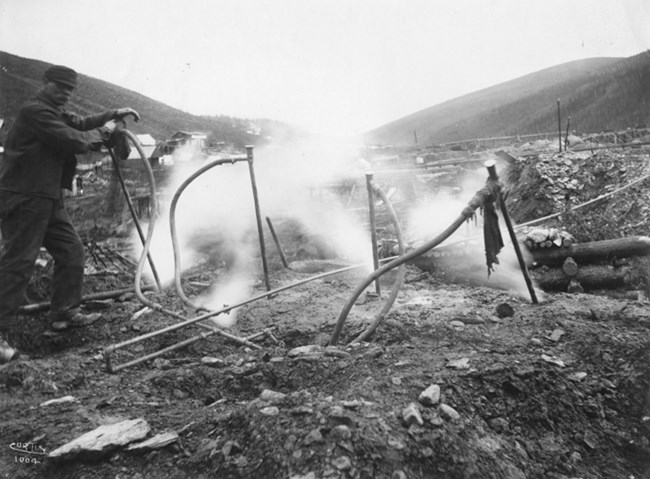
Courtesy of Eagle Historical Society
Large mining operations in the Klondike and Alaska were soon importing boilers that weighed several tons and could power dozens of steam points at a time. The units cost thousands of dollars and were so heavy that a steamboat was needed to deliver them up the Yukon and a bobsled with a team of horses was necessary to deliver them to mining sites. But for the pick-and-shovel miners, who formed partnerships of two or three men, huge boilers were not an option. Small-scale miners were frequently on the move and needed a thawing machine to sink prospecting holes and to thaw modest amounts of "paydirt" in remote locations. For them the only way was to have a custom boiler built that was light enough to be carried or transported by dog sled. Instead of the barrel shape of traditional boilers, these novelties were small and boxy and received the nickname "doghouse boilers." 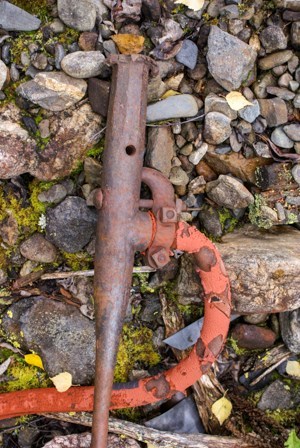
NPS/Chris Allan
The new boiler was a machine shop creation assembled from parts already available in mining centers like Dawson and Fairbanks. To reduce weight, the typical unit was a simple box of riveted sheet metal with a set of water tubes inside. And instead of having its own fire-box like traditional boilers, it was heated from below by a fire built on the ground. But, like a full-size boiler, the doghouse boiler also needed a safety valve to prevent explosions, an asbestos jacket to prevent the fire from burning through the shell, and a pump to circulate water through the tubes. In 1938, in an effort to revive the flagging gold industry, the Northern Commercial Company in Fairbanks announced it had designed a boiler weighing 200 pounds that could be carried by two men using poles inserted through sturdy steel loops on the boiler's housing. A glass water-level indicator and brass pressure gauge made it a high-tech tool for the independent placer miner, and the boilers were snapped up by customers across the region. The package also came with a six-foot steam point, twelve feet of steam hose, and thirty feet of 3/8 inch pipe. 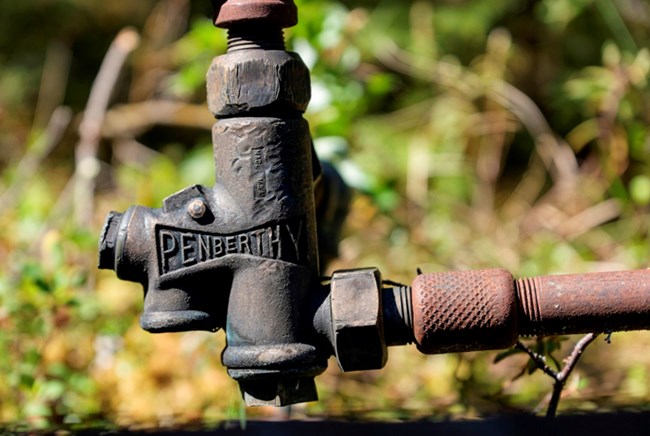
NPS/Josh Spice
Colorado Creek is a small tributary of Coal Creek in the heart of what is today Yukon-Charley Rivers National Preserve. During the Klondike-Alaska gold rush wandering prospectors found coal and then gold in the Coal Creek drainage. By 1935 most of the small-scale gold miners who held claims along Coal Creek had sold out to a gold dredging operation run by former University of Alaska president Ernest Patty. Although the gold dredge obliterated most evidence of the old-timers' work, some examples of their earlier, small-scale approach remain. In the spruce forest and tussock mounds along Colorado Creek, hikers will find old trails for winter travel, the ruins of a miner's cabin (a tiny example at 11x11 feet), and the doghouse boiler prospectors used in their search for gold-rich gravel deposits. Today at least four examples of this uniquely northern thawing apparatus can be found in the national preserve and they exist as reminders of the fierce determination and ingenuity of gold-seekers along this stretch of the Yukon River corridor. |
Last updated: August 17, 2015
